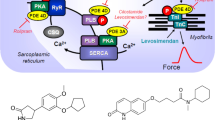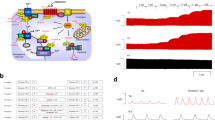Summary
Stereoisomers often exhibit differences in their pharmacological activities. Therefore, the phosphodiesterase inhibitory effects of the cardiotonic agent saterinone in form of the racemate were investigated in comparison with the inhibitory properties of its enantiomers R(+)- and S(−)-saterinone. For this purpose the phosphodiesterase isoenzymes from ventricular tissue of failing human hearts and porcine hearts were separated by DEAE-sepharose anion exchange chromatography. Four different phosphodiesterase isoenzymes were isolated from failing human myocardium and designated phosphodiesterase I–IV. Three phosphodiesterase isoenzymes could be separated from ventricular tissue of porcine hearts. A Ca2+/calmodulin stimulated phosphodiesterase I was not detectable in porcine myocardium.
In failing human hearts racemic saterinone was a potent inhibitor of phosphodiesterase III (IC50 0.02 μmol/l) and IV (IC50 0.03 μmol/l) as compared to the inhibition of phosphodiesterase I (IC50 37.3 μmol/l) and II (IC50 51.4 μmol/l). In comparison with the racemate, R(+)- and S(−)-saterinone showed only slight differences in their phosphodiesterase inhibitory effects. R(+)-saterinone inhibited phosphodiesterase III slightly but significantly more potently and selectively than did S(−)-saterinone. Compared to the inhibition of phosphodiesterase I and II both enantiomers were similarly potent and selective inhibitors of phosphodiesterase III and IV. Similar results were obtained in porcine hearts.
It is concluded that the racemate saterinone and its enantiomers R(+)- and S(−)-saterinone are virtually equipotent concerning the inhibition of phosphodiesterase isoenzymes isolated from failing human hearts or porcine ventricular tissue. The enantiomers of saterinone did not exhibit distinct stereoselectivity in their phosphodiesterase inhibitory effects.
Similar content being viewed by others
References
Armah BI, Hofferber E, Jacobitz P (1988a) Positive isotropic and vasodilatory actions of saterinone in vivo. Arzneimittelforschung 38:1303–1309
Armah BI, Hofferber E, Stenzel W (1988b) Pharmacological properties of the positive isotropic and α1-adrenoceptor blocking agent saterinone. Arzneimittelforschung 38:1287–1292
Armah BI, Muster D, Raap A, Brückner R, Graziadei I (1989) Lack of stereoselectivity in the isotropic and phosphodiesterase inhibitory effects of saterinone enantiomers. Arzneimittelforschung 39: 1384–1392
Bauer AC, Schwabe U (1980) An improved assay of cyclic 3′,5′-nucleotide phosphodiesterases with QAE-Sephadex columns. Naunyn Schmiedebergs Arch Pharmacol 311:193–198
Beavo JA, Reifsnyder DH (1990) Primary sequence of cyclic nucleotide phosphodiesterase isozymes and the design of selective inhibitors. Trends Pharmacol Sci 11:150–155
Bethke T, Klimkiewicz A, Kohl C, von der Leyen H, Mehl H, Mende U, Meyer W, Neumann J, Schmitz W, Scholz H, Starbatty J, Stein B, Wenzlaff H, Döring V, Kalmár P, Haverich A (1991) Effects of isomazole on force of contraction and phosphodiesterase isoenzymes I–IV in nonfailing and failing human hearts. J Cardiovasc Pharmacol 18:386–397
Bradford MM (1976) A rapid and sensitive method for the quantitation of microgram quantities of protein utilizing the principle of protein-dye binding. Anal Biochem 72:248–254
Brunkhorst D, von der Leyen H, Meyer W, Schmidt-Schumacher C, Scholz H (1988) Selective inhibition of cAMP phosphodiesterase III activity by the cardiotonic agent saterinone in guinea pig myocardium. Arzneimittelforschung 38:1293–1298
Brunkhorst D, von der Leyen H, Meyer W, Nigbur R, SchmidtSchumacher C, Scholz H (1989) Relation of positive isotropic and chronotropic effects of pimobendan, UD-CG 212 Cl, milrinone and other phosphodiesterase inhibitors to phosphodiesterase III inhibition in guinea-pig heart. Naunyn Schmiedebergs Arch Pharmacol 339:575–583
Colucci WS, Wright RF, Braunwald E (1986) New positive isotropic agents in the treatment of congestive heart failure. N Engl J Med 314:290–299, 349–358
Kakiuchi S, Yamazaki R, Teshima Y, Uenishi K, Yasuda S, Kashiba A, Sobue K, Ohshima M, Nakajima T (1978) Membrane-bound protein modulator and phosphodiesterase. Adv Cyclic Nucleotide Res 9:253–263
Komas N, Lugnier C, Le Bee A, Serradeil-Le Gal C, Barthélémy G, Stoclet JC (1989) Differential sensitivity to cardiotonic drugs of cyclic AMP phosphodiesterases isolated from canine ventricular and sinoatrial-enriched tissues. J Cardiovasc Pharmacol 14:213–220
von der Leyen H, Mende U, Meyer W, Neumann J, Nose M, Schmidz W, Scholz H, Starbatty J, Stein B, Wenzlaff H, Döring V, Kalmár P, Haverich A (1991) Mechanism underlying the reduced positive isotropic effects of the phosphodiesterase III inhibitors pimobendan, adibendan and saterinone in failing as compared to nonfailing human cardiac muscle preparations. Naunyn Schmiedebergs Arch Pharmacol 344:90–100
van Meel JCA, Zimmermann R, Diederen W, Erdmann E, Mrwa U (1988) Increase in calcium sensitivity of cardiac myofibrils contributes to the cardiotonic action of sulmazole. Biochem Pharmacol 37:213–220
Meyer W, Nose M, Schmitz W, Scholz H (1984) Adenosine and adenosin analogs inhibit phosphodiesterase activity in the heart. Naunyn Schmiedebergs Arch Pharmacol 328:207–209
Muller B, Lugnier C, Stoclet JC (1990) Involvement of rolipram-sensitive cyclic AMP phosphodiesterase in the regulation of cardiac contraction. J Cardiovasc Pharmacol 16:796–803
Muller B, Stoclet JC, Lugnier C (1992) Cytosolic and membrane-bound phosphodiesterases from guinea pig cardiac ventricles. Eur J Pharmacol 225:263–272
Nicholson CD, Challis RAJ, Shahid M (1991) Differential modulation of tissue function and therapeutic potential of selective inhibitors of cyclic nucleotide phosphodiesterase isoenzymes. Trends Pharmacol Sci 12:19–27
Podzuweit T, Nennstiel P, Müller A, Schaper W (1991) Abscence of soluble calcium-calmodulin-stimulated cyclic nucleotide phosphodiesterase in pig myocardium. J Mol Cell Cardiol 23(Suppl V):P217
Reeves ML, Leigh BK, England PJ (1987) The identification of a new cyclic nucleotide phosphodiesterase activity in human and guinea-pig cardiac ventricle. Biochem J 241:535–541
Rudolph M (1990) Direct enantiomeric separation of saterinone by high-performance liquid chromatography. J Chromatogr 525: 161–168
Schultz JE, Schmidt BH (1986) Rolipram, a stereospecific inhibitor of calmodulin-independent phosphodiesterase, causes β-adrenoceptor subsensitivity in rat cerebral cortex. Naunyn Schmiedebergs Arch Pharmacol 333:23–30
Shahid M, Nicholson CD (1990) Comparison of cyclic nucleotide phosphodiesterase isoenzymes in rat and rabbit ventricular myocardium: Positive isotropic and phosphodiesterase inhibitory effects of Org 30029, milrinone and rolipram. Naunyn Schmiedebergs Arch Pharmacol 342:698–705
Silver PJ, Harris AL, Canniff PC, Lepore RE, Bentley RG, Hamel LT, Evans DB (1989) Phosphodiesterase isozyme inhibition, activation of the cAMP system, and positive inotropy mediated by milrinone in isolated guinea pig cardiac muscle. J Cardiovasc Pharmacol 13:530–540
Tenor H, Bartel S, Krause EG (1987) Cyclic nucleotide phosphodiesterase activity in the rat myocardium: Evidence of four different PDE subtypes. Biomed Biochem Acta 46:S749-S753
Thompson WJ, Appleman MM (1971) Multiple cyclic nucleotide phosphodiesterase activities from rat brain. Biochemistry 10: 311–316
Weishaar RE, Kobylarz-Singer DC, Steffen RP, Kaplan HR (1987) Subclasses of cyclic AMP-specific phosphodiesterase in left ventricular muscle and their involvement in regulating myocardial contractility. Circ Res 61:539–547
Wenzlaff H, Scholz H, Zimmermann W (1992) Selectivity of different phosphodiesterase inhibiting agents for phosphodiesterase III and IV from porcine ventricular heart tissue. Naunyn Schmiedebergs Arch Pharmacol 345 (Suppl): R74
Zimmermann W, Schmidt-Schumacher C, Scholz H (1991) Effects of the enantiomers of saterinone on the phosphodiesterase isoenzymes I–IV of failing human hearts in comparison with the racemate. Naunyn Schmiedebergs Arch Pharmacol 344 (Suppl):R82
Author information
Authors and Affiliations
Additional information
Correspondence to: W. Zimmermann at the above address
Rights and permissions
About this article
Cite this article
Zimmermann, W., Scholz, H., Schumacher, C. et al. Effects of saterinone and its enantiomers R(+)-saterinone and S(−)-saterinone on the phosphodiesterase isoenzymes from ventricular tissue of failing human hearts and porcine hearts. Naunyn-Schmiedeberg's Arch. Pharmacol. 349, 611–618 (1994). https://doi.org/10.1007/BF01258467
Received:
Accepted:
Issue Date:
DOI: https://doi.org/10.1007/BF01258467




